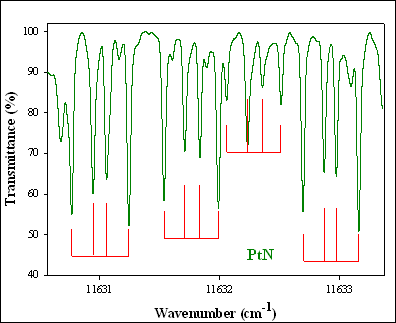

43751-B6
Spectroscopy of Gas Phase Palladium- and Platinum-Containing Radicals
Research this year has focused on the spectroscopy of several platinum compounds, PtO, PtC, and PtN.
Using intracavity laser absorption spectroscopy (ILS), we have recorded the PtO spectrum in the 12000 cm-1 – 13000 cm-1 region. A strong electronic transition of PtO was observed with an origin at 12118.5 cm-1; it is identified as the (0,0) band of the A30+ – x1 electronic transition. Line positions and molecular parameters for the A30+ and x1 states are presented. Although this transition has been observed previously by Sassenberg and Scullman [1], our work shows improvements in measured line positions (0.006 cm-1 accuracy compared to 0.02 cm-1), and presents new parameters which are consistent with the transitions that we observed. Additionally, this work represents the first time the ILS technique has been successful at recording molecular spectra from an excited electronic state. This may further increase the spectroscopic applications where ILS is the technique of choice. Recently we have completed our work on this electronic transition of PtO: a manuscript has been accepted and scheduled for publication in the Journal of Molecular Spectroscopy.
We have recorded several vibrational bands of the A" 1Σ+ - X 1Σ+ transition of PtC. The molecular absorption spectrum of PtC was measured at Doppler-limited resolution using intracavity laser absorption spectroscopy (ILS), which located in UM-St. Louis, in the laboratory of our collaborator, Dr. James. O'Brien. Initially, strong bandheads were observed at 12656 cm-1 and 12547 cm-1. Based on previous work on PtC from Appelblad et al. [2] the 12656 and 12547 cm-1 bands were assigned as the (0,0) and (1,1) bands of the A” 1Σ+ – X 1Σ electronic transition. Based on published low J line positions determined from a molecular beam study [3], the assignments were straight forward. In the R-branch, the lines are doubled due to the 194PtC and 196PtC isotopologues. Additional experiments recorded the (2,2), (1,0), and (2,1) bands of PtC. An analysis of the five observed vibrational bands of 194PtC and 196PtC is nearing completion.
The ACS-PRF award supports our research and positively
impacts our careers by providing funding for research supplies, travel for
conferences, and salary for summer work. Platinum intermediates are
important in many catalytic reactions, and this research provides insight into
the electronic structure and bonding of Pt-ligand
fragments.
1. U. Sassenberg and R.
Scullman, Phys. Scr. 28 (1983), 139-159.
2.
0. Appelblad, C. Nilsson and R. Scullman, Phys. Scr. 7 (1973), 65-71.
3. 4. E.J. Friedman-Hill and R.W. Field, J. Chem.
Phys. 100 (1994), 6141-6152.
5. K.Y. Jung, T.C. Steimle, D. Dai, and K. Balasubramanian, J. Chem. Phys. 102 (1995), 643-652.
 We
have observed a new near-infrared electronic transition of PtN,
with a bandhead at 11737 cm-1. PtN has previously been observed in the visible region by
Friedman-Hill and R.W. Field [4] and Steimle et al.
[5]. Four branches have been identified. A portion of the new PtN spectrum is shown in the accompanying Figure. The
quartet structure highlighted in the figure is a combination of isotope and
nuclear hyperfine structure. The three major isotopes of platinum (194Pt,
195Pt, and 196Pt) have approximately the same abundance
(~30% each) which would produce a triplet pattern, and 195Pt has a
nuclear spin of I=1/2 which splits the central peak into two smaller peaks
creating the symmetrical quartet pattern. Analysis of this new electronic
transition is in progress.
We
have observed a new near-infrared electronic transition of PtN,
with a bandhead at 11737 cm-1. PtN has previously been observed in the visible region by
Friedman-Hill and R.W. Field [4] and Steimle et al.
[5]. Four branches have been identified. A portion of the new PtN spectrum is shown in the accompanying Figure. The
quartet structure highlighted in the figure is a combination of isotope and
nuclear hyperfine structure. The three major isotopes of platinum (194Pt,
195Pt, and 196Pt) have approximately the same abundance
(~30% each) which would produce a triplet pattern, and 195Pt has a
nuclear spin of I=1/2 which splits the central peak into two smaller peaks
creating the symmetrical quartet pattern. Analysis of this new electronic
transition is in progress.